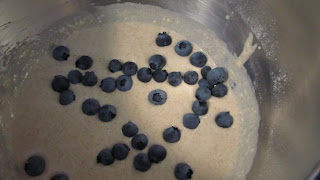Last year, as part of my CSA meat share, I got two whole chickens. These beautiful birds have been sitting idle in my freezer since then, and that's unacceptable. I've wanted to try beer can chicken for a long time, and I finally did it! This was a huge learning experience for me. I used
this recipe as a guide, and I made several alterations based on others' comments and my own intuition. It might be easiest if I go through the process step-by-step.
Of course, two days before I planned to grill the chicken, I took it out of the freezer and put it in the fridge to thaw. It felt like Thanksgiving, friends. A very small Thanksgiving, but Thanksgiving nonetheless! It was very exciting!
 |
| My dear chicken, who I thanked for its life. |
The night before I planned to grill the chicken, I made a "sauce" of melted butter and two packets of some amazing Indian spices (labeled as goan fish curry). I loosened the skin from the chicken and shoved as much of the sauce as I could under the skin - but I saved some to add to the beer for the grilling process. This was also a learning experience, as I've never loosened chicken skin before. Basically, don't worry too much about ripping the skin, and let your fingers do the work. Oh, and use a glove (or two). :) After I seasoned the chicken, I covered it and put it in the fridge over night (along with the reserved butter/curry sauce).
 |
| Seriously, use a glove! |
 |
| The chicken after I rammed magic sauce in every crevice, nook, and cranny! |
So, the recipe says to preheat an outdoor grill to low heat. Since my grill has a thermometer (that measures the inside temp of the grill), I preheated it to 350. Just FYI, a good general guideline for grilling chicken is 15 minutes per pound at 350 degrees. Also, it's important to be sure you've got enough propane to get the job done, since the bird will need to be out there at least an hour (depending on the size of your bird).
Here's a great website with instructions on how to calculate how much propane you have in your tank.
While the grill was heating, I warmed up the sauce I'd reserved from the marinating process and found a good use for the 1/2 can of beer. (Side note: WTH would the directions tell you to "DISCARD" half the beer?!?!?! That is such a complete waste!) I had some blueberries from the bush in my back garden, and I added them to the beer like they do for the "Blueberry Blonde" at Coddington Brewing Company. :)
 |
| Discard the extra beer? NO WAY!!! |
I forgot to mention that I took the beer out of the fridge along with the chicken, as it helps if the beer is room temp when you add the butter sauce. Anyway, I added the butter sauce to the beer (I had to put it all into a used seltzer can since I drink beer out of bottles!) and sprayed the can with some cooking spray (this helps it slide out of the chicken much easier after grilling is complete).
 |
| Chicken, meet can. Can, meet chicken. |
The recipe says to use a disposable baking sheet, which I thought sounded like one of the worst ideas ever. I used a 9x9 glass baking dish instead, because it is very stable and holds up to heat very well. Someone suggested lining the baking sheet/dish with foil to make cleanup easier, but I decided I preferred stability over ease of cleanup (I thought the foil might make things slide around). The other thing to remember BEFORE you start the arduous journey from the kitchen to the grill is - if you have a bun rack attached to the lid of the grill, you will probably need to remove it for the lid to close properly. This is something you may want to test ahead of time.
 |
| Whew! We made it to the grill!!! |
Ok, so my dear little chicken made it to the grill, I had enough gas, I drank the blueberry beer, and about an hour and a half later...
 |
| The best chicken I've ever tasted! |
...I ate some of the best chicken I've ever tasted! People, I HATE CHICKEN SKIN!!! I think it is the most disgusting thing! The skin on this chicken was unbelievable! I seriously just sat and ate skin. The skin was better than the meat - no joke! It was absolutely delicious!!! I threw a couple of sweet potatoes on the grill with the chicken, so for the next few nights I had chicken and sweet potatoes for dinner...FABULOUS!
One more important side note is that the beer will bubble up out of the can, and that's ok. As you can see from the condition of my baking dish - this is a messy operation. Also, keep your eye on the neck, as part way through grilling you may need to cover it. I put some foil over my bird at about the 45 minute mark or so, and I'm glad I did. ENJOY!!!































